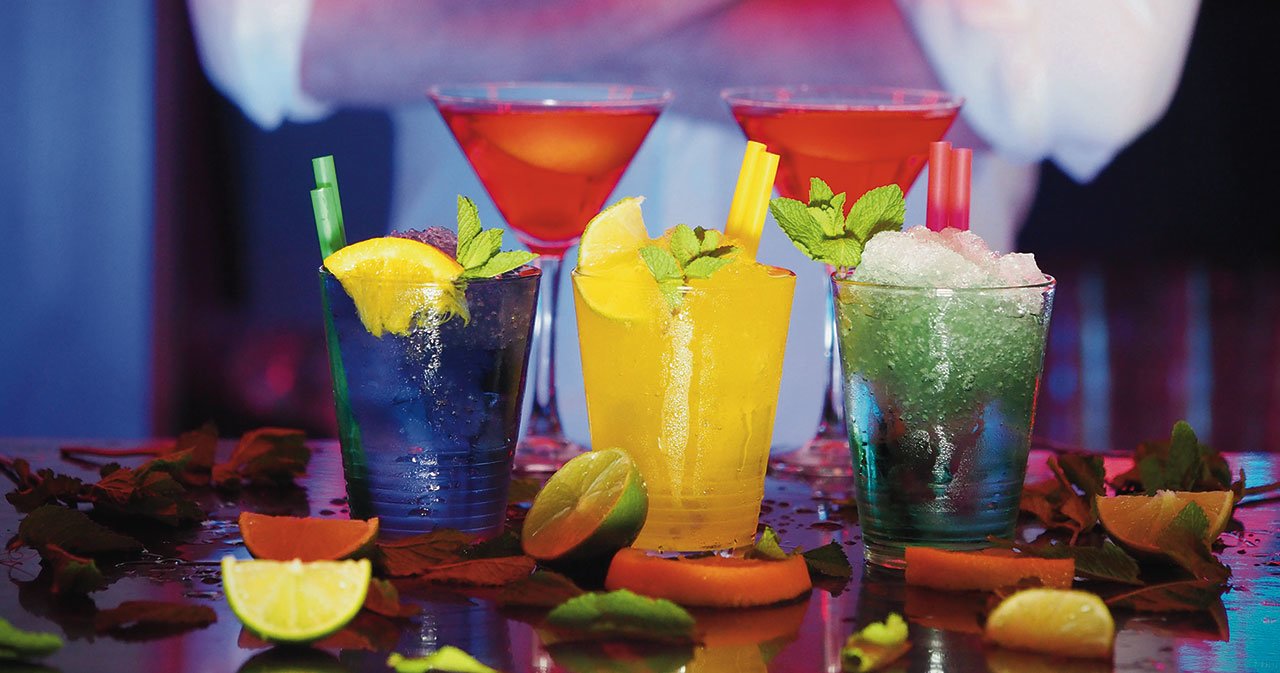Cocktails & Spirits – Shake Up the Drinks Menu
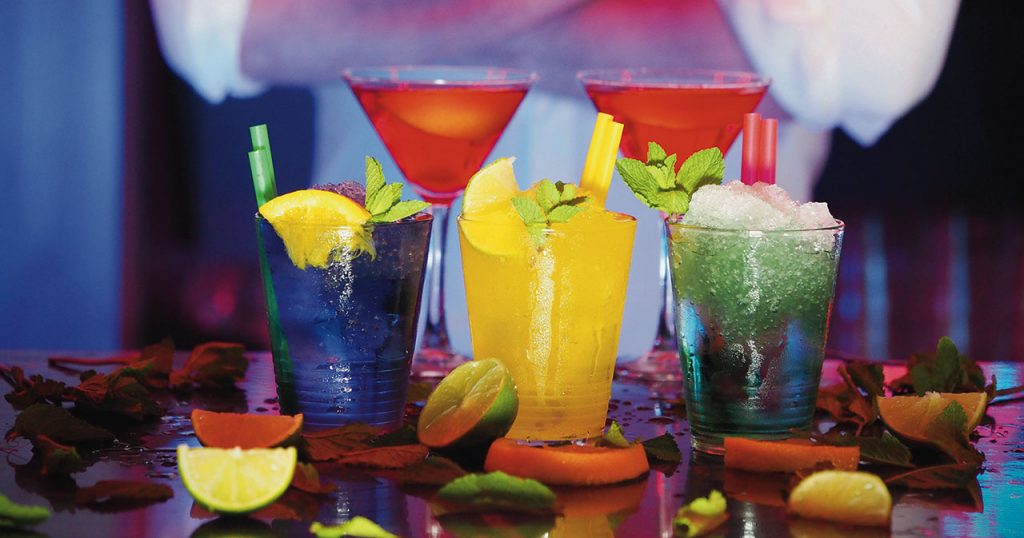
“No amount of physical contact could match the healing powers of a well made cocktail.”
David Sedaris
Are you tapping into one of the industry’s most popular and profitable trends? If not, why not?
Our love of cocktails is growing, and whilst volume of alcohol sales in recent years have not grown value certainly has and cocktails are a great way of boosting the bottom line.
So, what is a cocktail?
Cocktail refers to an alcoholic drink, which consists of a mixture of spirits such as gin, brandy, vodka, whiskey, tequila, or rum mixed with other ingredients such as fruit juice, cream, honey, milk, sugar, herbs, or other flavourings!
The number of on-trade outlets serving cocktails has risen by 75% since 2014 since 2014 bringing the total to 42,000, with nine million consumers now drinking cocktails on a night out. And 6.5 million customers now choose to drink a cocktail with a meal when eating out, and our “thirst for cocktails” means that operators really do have to be at the top of their game!
The UK cocktail market is now worth over £587m, proving to be an enormously beneficial addition to an outlet’s drinks range, setting you apart from your competition and importantly, increase your customers spend per head.
Ben Anderson, marketing director at Funkin Cocktails, said: “From high-end bars to high-footfall venues and everything in-between, cocktails are in huge demand and consumers are happy to pay a premium for a great-looking, great-tasting cocktail.
“Cocktails are becoming more accessible than ever before and we see the biggest growth coming from mainstream outlets.
“The nation’s love affair with cocktails isn’t waning and we would urge those outlets not serving mixed drinks to grab the opportunity and drive footfall and incremental sales.”
 Data from industry analysts CGA revealed that the average price of a cocktail has increased by 51p year-on-year and people in London are now willing to pay £7.67 while drinkers outside the capital would happily pay up to £6.77.
Data from industry analysts CGA revealed that the average price of a cocktail has increased by 51p year-on-year and people in London are now willing to pay £7.67 while drinkers outside the capital would happily pay up to £6.77.
Anderson added: “Research also reveals that up to 69% of people choose cocktails spontaneously so the opportunity to attract new customers, increase profit per serve and drive footfall is huge just by adding a few classic cocktails to a drinks menu.”
The report reveal that cocktails continue to rise in popularity across British bars, pubs and restaurants, with the addition of aperitifs and healthy options helping to sustain the momentum.
Texture
Cocktails with proper texture result in drinks that feel substantial. Ice is one way to deliver the correct texture and flavor in a cocktail, in addition to providing a visual impact. For example, large blocks of ice minimize dilution and can also be branded or stamped. Medium sized cubes continue to be used for a variety of all-purpose cocktails, and shaved or nugget ice is being used in large part to often dilute boozy, tiki-styled cocktails. Finally, blended cocktails continue to grow in popularity. Beyond ice, texture can also be modified by using egg whites to not only add a foam presentation, but also a soft texture to a variety of citrus-forward cocktails.
Veggies
While consumers have long embraced healthy green juicing and smoothies, vegetable flavors such as cucumber, celery, peppers, and peas are now being used to add a new twist to familiar cocktails. Bartenders are also using spirits that have vegetal characteristics, such as Green Chartreuse or its milder, slightly sweeter, lower-alcohol cousin, Yellow Chartreuse. Aquavit, a spirit often infused with caraway and dill, is also being used to add vegetal flavour. Using vegetables and vegetal spirit ingredients, such as bell peppers, beets, and snap peas, adds fresh, bright flavours and imparts unique, vibrant colours.
Bitters
No longer just to enjoy after dinner, amaro and bitters are being used more and more due to their ability to tone down and balance drinks that are too tart or sweet. One example is Aperol—a bitter orange liqueur that adds astringency, bitterness, and also a wonderful colour. Cynar is an artichoke based bittersweet liqueur known for its versatility and distinctive flavour; its taste is enriched by an infusion of 13 herbs and plants. The name of the drink derives from the botanical name for artichoke, as artichoke leaves lend the distinctive flavour. Angostura bitters, traditionally used as an accent ingredient, is also making its way to the forefront as a major ingredient in cocktails.
Wine
Wines are great on their own, but they also lend themselves well to cocktail development. When used in cocktails, wines reduce the need to add excessive amounts of alcohol (that can make a drink too boozy) and can add a softer sweetness than syrups. These include fortified wines like ports and vermouths; subtle nutty or creamy sherries; crisp and clean red and white wines; and sparkling wines for bubbly texture. And red wine, traditionally just for sangria, is being used to create colorful, flavorful cocktails at some of the country’s most innovative watering holes.
Coffee & Tea
Coffee and tea as cocktail ingredients are being leveraged for their smoothness, earthiness, subtle smokiness, and other flavour tones—as well as for their strong backbone, which stands up to more assertive spirits. While cold brew primarily delivers a singular flavour profile, teas from around the world offer versatility and more nuanced flavours. These range from the subtle and delicate aromas of white tea; slight bitterness of many black teas (or subtle smokiness of Lapsang souchong); roasty notes from green teas like houjicha; soft, grassy flavours in matcha tea; or the range of flavours and aromas of oolong tea. Then there’s the incredibly diverse flavours extracted from herbal and floral teas including hibiscus or chamomile.
CGA’s Mixed Drinks Report shows that the value of on-trade cocktail sales jumped by 7.5% year on year in the first quarter of 2018, outpacing a 4% increase in the wider spirits market. An estimated 8.7 million British consumers now enjoy cocktails when drinking out-of-home.
The research also revealed that the Mojito remains Britain’s favourite cocktail—though the Pornstar Martini is rapidly closing the gap. Aperitifs like the Aperol Spritz are meanwhile increasingly popular across bars, pubs and restaurants, with more than two in five (42%) cocktail drinkers now likely to enjoy a cocktail before a meal. Sparkling cocktails are another big growth area.
CGA’s Mixed Drinks Report also emphasised the value of promotions in cocktail sales. Close to half (44%) of cocktail drinkers say they use promotions like two-for-one deals, Happy Hours or other discounts every or almost every time they order one, and three quarters (77%) are more likely to visit a venue if it has a cocktail promotion. Menus, bartenders’ recommendations and theatre of serve are among the other big factors influencing cocktail drinkers’ choices.
Charlie Mitchell, senior consumer research manager at CGA, said: “Cocktails have been a boom area of the drinking-out market for a while now, but our Mixed Drinks Report shows that sales and consumer interest are both still on the up. This is a market that is evolving fast, and the popularity of low-sugar and low-alcohol drinks is just one of a host of trends that all businesses selling and supplying cocktails need to be aware of. Staying right on top of people’s needs and preferences is crucial if brands are to protect and increase their share of this lucrative market.”
The importance of cocktails as a summer’s drink cannot be overstated, summer is the perfect time to revitalise, refresh and invigorate your drinks offering and excite your customers with unconventional and avant-garde, options.
Spirits Join the Boom
With the cocktail market in a boom period, spirits should not be forgotten.
Spirits now have a 22.1% share of all drinks sales by value, according to CGA’s On-Premise Measurement Service – up by two percentage points in just four years.
CGA’s Director of Client Services Jonny Jones commented, “The spirits category is a hugely important revenue driver for the trade, and one that is helping operators to sustain growth in a challenging marketplace.”
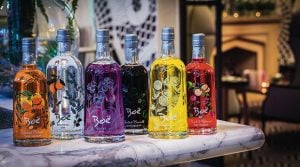 Distilled on site in the village of Throsk near Stirling, Boë Gin is now one of the biggest independent gin producers in Scotland. Comprising of six products, the Boë Gin range includes two full strength flavoured gins – Boë Violet and Boë Passion – a classic gin, Boë Scottish Gin, and three flavoured gin liqueurs – Peach and Hibiscus, Spiced Orange and Scottish Bramble.
Distilled on site in the village of Throsk near Stirling, Boë Gin is now one of the biggest independent gin producers in Scotland. Comprising of six products, the Boë Gin range includes two full strength flavoured gins – Boë Violet and Boë Passion – a classic gin, Boë Scottish Gin, and three flavoured gin liqueurs – Peach and Hibiscus, Spiced Orange and Scottish Bramble.
Their first flavoured gin, Boë Violet was launched in 2016 and was one of the first full strength flavoured gins to market. The vibrant flavoured spirit infused with violet flowers proved so popular that Boë continued to innovate in the flavoured category. Boë Passion, a second full strength flavoured gin, this time using on-trend passionfruit was introduced earlier this year and is already performing well at wholesalers.
Boë’s popularity shows no signs of slowing, with figures filed to February 2019 showing total sales revenue reached £8.5 million, up from £1.1M the previous year. Following UK listings in the on and off-trade across their portfolio of full-strength gins and liqueurs, an increase in sales has contributed to an increase of over £1.1million in operating profits, compared to previous year.
The brand is now available right the across the UK, in over 300 Morrisons stores and can be found in over 11,000 cocktail bars, restaurants and pubs.
Brand New Drinks Reach Super Stardom
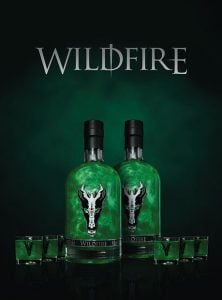 UK distributors for the 2 beverages, Eliot’s are the only supplier to be offering a unique drink inspired by the world wide recognised GAME OF THRONES Dragons Breath “ Wildfire” whisky and cinnamon spirit drink.
UK distributors for the 2 beverages, Eliot’s are the only supplier to be offering a unique drink inspired by the world wide recognised GAME OF THRONES Dragons Breath “ Wildfire” whisky and cinnamon spirit drink.
The Eliot’s Wildfire Game of Thrones themed drink is a striking, eye catching green product infused with micro-ionised shimmering particles delivering a highly branded, highly sought after, irridescent drink, which glistens in the bottle and in the glass once poured.
The micro-ionised elements add an eye catching glistening effect to the 33% spirit drink.
The second new launch of 2019 for Eliot’s is Libellis, a premium Gin beverage which can be served as a shot or as a tall drink with a mixer. Also infused with Eliots micro-ionised fruits, Libellis has a clear appearance, like most main stream gins, until the item is shaken, then the micro ionised strawberry particles transform the drink into a glistening red gin, right before the customers eyes.
With a sweet taste, the strawberry blend Gin is versatile to be served with various mixers or a shimmering shot and offers great theatrical allure for customers.
A new fruity dimension to 2019 offerings, and worldwide recognised branding will take your premises to super stardom level this new year.
Paragon Brands Launch JUNE Gin Liqueur
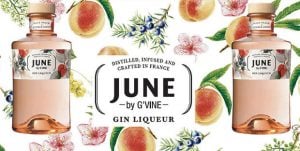 Paragon Brands are proud to announce the UK launch of JUNE gin Liqueur by Maison Villevert in Cognac, France. Created by Jean-Sebastian Robiquet Creator of Ciroc Vodka and G’vine Gin. JUNE Gin Liqueur uniquely blends premium G’Vine grape-distillate Gin with the flavor of fresh wild peaches and botanicals of the JUNE flower, which only blooms for 2 days each June on the Ripening grape vines of the Cognac Vineyards.
Paragon Brands are proud to announce the UK launch of JUNE gin Liqueur by Maison Villevert in Cognac, France. Created by Jean-Sebastian Robiquet Creator of Ciroc Vodka and G’vine Gin. JUNE Gin Liqueur uniquely blends premium G’Vine grape-distillate Gin with the flavor of fresh wild peaches and botanicals of the JUNE flower, which only blooms for 2 days each June on the Ripening grape vines of the Cognac Vineyards.
Chris Jones, MD of Paragon Brands, commented ‘Jean Sebastien and Maison Villevert have done an incredible job of capturing the tastes and aromas of fresh wild peaches and marrying them perfectly with a delicate balanced floral Gin. This offers both Traditional and contemporary gin drinkers something new and unique to add to their drinks repertoire, with excellent mixability beyond the usual tonic serve, JUNE works perfectly in a Spritz or with Prosecco in a Peach-Gin Belini’.
Don’t Forget the Mixers
Premium soft drinks producer Peter Spanton Drinks is expanding its range ahead of the key summer sales season with the launch of two new authentic flavours, Peter Spanton No. 2 Lemonade With Italian Bitters and Peter Spanton No.16 Cream Soda.
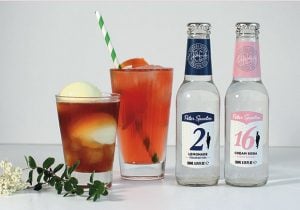 As with the other varieties in the range, they can be enjoyed alone, as a mixer with spirits, and in both alcoholic and non-alcoholic cocktails. The new launches build on the established success of the drinks range created in 2012 by entrepreneur Peter Spanton, former owner of Vic Naylor’s restaurant in Clerkenwell.
As with the other varieties in the range, they can be enjoyed alone, as a mixer with spirits, and in both alcoholic and non-alcoholic cocktails. The new launches build on the established success of the drinks range created in 2012 by entrepreneur Peter Spanton, former owner of Vic Naylor’s restaurant in Clerkenwell.
Spanton said: “We wouldn’t bring anything to market that didn’t deliver something different, and these new recipes do exactly that. I initially devised our range because there simply weren’t enough genuinely adult non-alcoholic choices, and despite the growth of the market, there is still a real need for distinctive soft drinks choices for consumers and operators.”
Peter Spanton No. 2 Lemonade With Italian Bitters is described by Spanton as “more Talented Mister Ripley in style than the sugary kids’ soda everyone knows. The flavour is inspired by the romance of the Riviera, and is a homage to Italy’s aperitivo culture.” It can be enjoyed served simply with a slice of orange, or pairs well with a premium vodka. Tasting notes: Combines the fizz and punch of sharp sherbet lemons with the oily swagger of a fine negroni. Refreshing Sicilian lemon in the mouth subsides into warmer, richer aromatics on the nose.
Peter Spanton No.16 Cream Soda is a reimagining of the classic cream soda, originally patented as a temperance drink in Vienna, New Jersey in the 1850s. “It has a really sensual mouth feel and rich flavour, capturing the spirit of sultry summers,” said Spanton. As well as working very well on its own, it mixes superbly with American Whiskey. Tasting notes: Soft, rich, buttery bubbles fill the mouth with vanilla and cream. A refreshingly rich quencher, as satisfying as the first ice-cream of summer on a warm pebbly beach.
Spanton adds: “Consumers are seeking out authentic flavours, and they want to know that there’s a genuine story behind their drink. Alongside a classic cocktail or spirit-and-mixer serve, they increasingly expect a soft drink to deliver the same premium, engaging experience, without leaving them feeling that a non-alcoholic choice is second best.”
In its January this year Drinks International released its list of the world’s best-selling classic cocktails in 2019, revealing that while bartenders may put a modern spin on old recipes, the desire for established, sophisticated drinks remains.
The website asked bartenders from 127 of the best bars in 38 countries around the world to rank their 10 best-selling cocktails.
9. Aperol Spritz – up two places and features in the top 10 for the first time, with 30% of bars naming it in their top 10
8. Margarita – down two places but it has retained its spot as the top tequila classic in our list 31% named it in the top 10
7. Espresso Martini – This coffee-based cocktail has climbed up two places this year and has been ranked in the top 10 by 32% of bars
6. Dry Martini – Despite being down two places from last year, 35% of bars still put it in their top 10
5. Manhattan – 10% say it’s in their top three and 40% say it’s in their top 14. Daiquiri- Daiquiri is the most ordered rum cocktail in the list.
3. Whiskey Sour – third place for the second year running
2. Negroni – This iconic Italian cocktail has been in second place for five years running
1. Old Fashioned – For the fifth year running The Old Fashioned has retained the top spot in the list
So now is the time to get creative but at the same time don’t forget the old classics!
www.boegin.com
www.eliots.com
www.peterspanton.com
www.paragonbrands.co.uk

